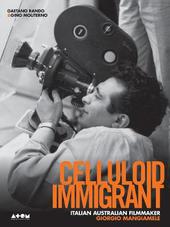
|
Celluloid Immigrant: Italian Australian Filmmaker Giorgio Mangiamele
Paperback
Main Details
| Title |
Celluloid Immigrant: Italian Australian Filmmaker Giorgio Mangiamele
|
| Authors and Contributors |
By (author) Gaetano Rando
|
|
By (author) Gino Moliterno
|
| Physical Properties |
| Format:Paperback | | Pages:148 | | Dimensions(mm): Height 240,Width 180 |
|
| Category/Genre | Films and cinema
Individual film directors and film-makers |
|---|
| ISBN/Barcode |
9781876467210
|
| Classifications | Dewey:791.430233092 |
|---|
| Audience | |
|---|
| Illustrations |
82 b&w photos
|
|
Publishing Details |
| Publisher |
Australian Teachers of Media
|
| Imprint |
Australian Teachers of Media
|
| Publication Date |
1 January 2012 |
| Publication Country |
Australia
|
Description
Giorgio Mangiamele is one of the most under-estimated figures in Australian cinema history. Soon after his arrival in Australia in 1952 as a migrant from Italy, he began making films at a time when feature film production in Australia was almost non-existent. His films were seldom seen in Australia, although one - Clay (1965) - was applauded overseas as an official selection in the Cannes Film Festival. Displaying almost quixotic ambition, Mangiamele's first venture into production was a feature film, IL CONTRATTO (1953), which he began within a year of arriving in Australia. This drama about the isolation and alienation of Italian migrants was never completed, but what remains is a remarkably powerful portrait of a neglected segment of Australian society. The following three films in this collection also express the anguish of the migrant experience: the two radically different versions of a short drama THE SPAG (c.1960-2), and a robust comedy, NINETY NINE PER CENT (1963). All of these films reveal Mangiamele's keen eye for visual poetry and the strong humanism of his concern for his characters. These qualities are amplified in his first completed feature film, CLAY, which explores the alienation, not of migrants, but of a man on the run from the police who is taken in by an isolated community of artists. His emerging love affair with a young sculptor leads to tragedy. The intensity of Mangiamele's breathtaking vision recalls the work of Jean Cocteau and other French romantic poet/filmmakers, and signifies the appearance of a major art cinema talent, imbued with European cinema culture, who tragically never found an opportunity to find full expression of his vision after this one extraordinary feature. "In vibrant film cultures, filmmakers of all ages and cultures work together, the young gaining immeasurably from associating with the experienced and differently orientated. Australia was too ageist, too narrow in its view about what sort of films ought to be made, for there to be space for a sensitive, inventive, deeply passionate filmmaker like Mangiamele." Scott Murray, Australian Cinema, Allen & Unwin in association with the Australian Film Commission, St Leonards, 1994. "At a time when most Australians believed they could only be viewers of cinema, Giorgio Mangiamele showed them that they could make their own films... He was genuinely heroic and a romantic in the best Quixotic sense." Phillip Adams
Author Biography
Gaetano Rando and Gino Moliterno are prominent Italian-Australian film academics.
|